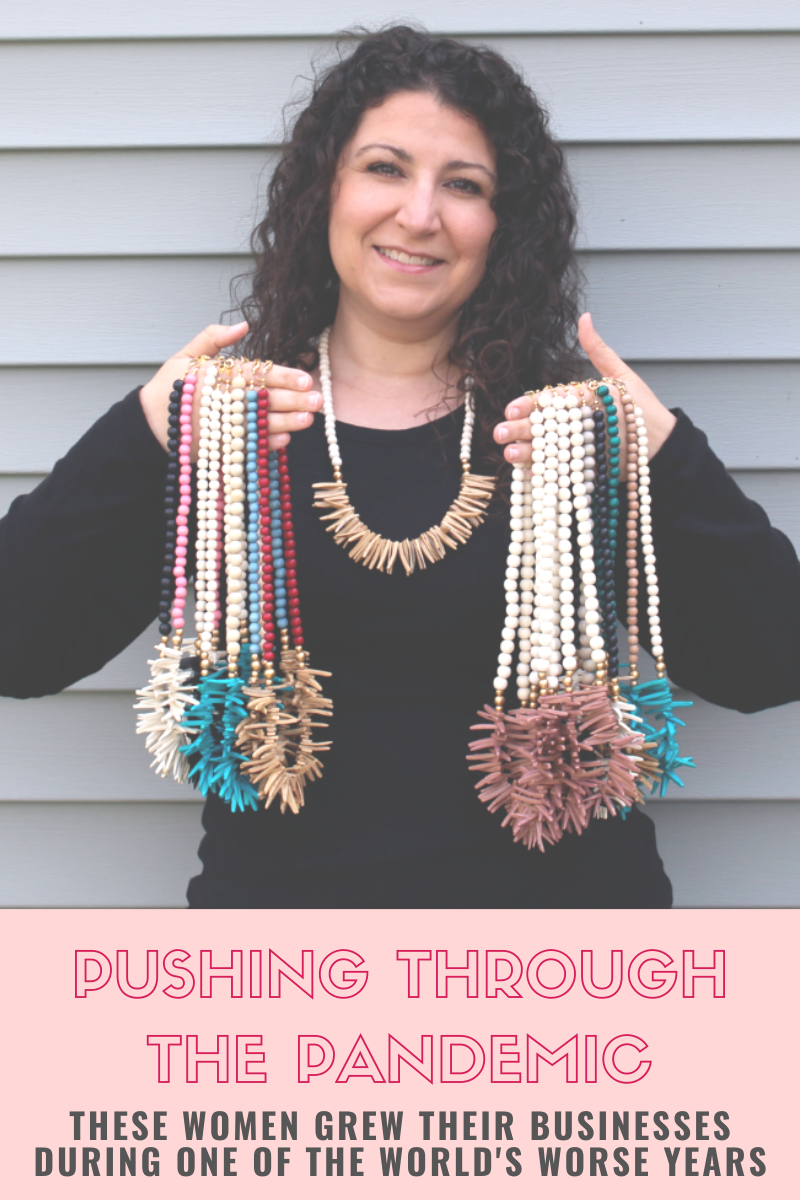Pushing through the pandemic: These women grew their businesses during one of the world’s worst years

When Kerri asked to interview for me for her senior thesis, I jumped at the chance. Kerri's focus and topic intrigued me as it hit so close to home. When 2020 hit, small business owners were shuttered. More often than not, we didn't know what to do or how to do it. This year would push every boundary - mentally, emotionally, physically, home life, family life, and our beloved businesses. Kerri beautifully interviews three female owned small businesses and examines how we pivoted and persevered.
------------------------------------
by Kerri Kolensky
Lynne Intintoli is frequently hunched over a desk, surrounded by beads. From glass to sterling silver, gold plated and brass, the small spheres are scattered across her desk in several stacks. These are no beads for a hobby. Intintoli has made jewelry since 2003, eventually turning what started as a stress-relieving activity into her own company, Lynnique. From her home in Wantagh, New York, she makes and sells a variety of items, including earrings, bracelets, bridal hair accessories and, more recently, beaded chains for face masks.
Creating a product to fit the needs of her customers was just one of the ways that Intintoli changed her company in response to the coronavirus pandemic’s impact on small businesses over the past year. Owners are still feeling the effects from the pandemic a year after Gov. Andrew Cuomo signed the “New York State on PAUSE” executive order that closed all non-essential businesses on March 22, 2020.
When the pandemic was in its earliest stages Intintoli doubted her ability to run her company. She did not think that people would even want to purchase accessories, saying, “it’s a worldwide pandemic. Who’s going to want a pair of earrings?”
It turns out that people did want jewelry, despite the fact that they had no restaurant, wedding or even workplace to go out and wear it to. Her revenue grew by 45% in 2020 compared to 2019, an unexpected increase that she contributes largely to harnessing the power of social media and pivoting her methods of sale to focus entirely online. Wanting to expand beyond her Etsy shop, she took advantage of having more time at home last March to launch her own website.
Despite her progress, Intintoli sighed that the past year was difficult. She and her husband were in a car accident a month before the pandemic, filling even more of her already busy schedule with doctor’s appointments that set her production back by months. Her three-year-old daughter constantly requires her attention, and her husband works full time from home as an engineer. In a phone interview she talked while sitting next to her daughter who frequently interrupted asking for toys. The days, and what she can get done, become unpredictable. “Thursday I had like my whole day planned, and it didn’t go so well because she just refused to nap.” she said.
She is not alone in dealing with these setbacks, especially since the pandemic disproportionately impacted women. The "Special Report on Women-Owned Small Businesses During COVID-19" released by the U.S. Chamber of Commerce showed that women-owned businesses were impacted more by the pandemic than male-owned ones. Using survey results gathered in July, the report showed that 62% of men characterized their companies’ health as “good” compared to only 47% of women.
There is no central way to track small business closures, but employment data helps establish a sense of the number of shuttered stores and who was hit especially hard. The Small Business Administration’s “Effects of the COVID-19 Pandemic on Small Businesses” March report showed that there was a 22.1% decrease in the total number of working self-employed women between April 2019 and April 2020. The number of working self-employed men decreased by 19.1% in the same time period.
One of the biggest challenges facing female entrepreneurs right now is increased responsibilities at home, according to Corrinne Graham, chair of the Women’s Business Committee for the Long Island Advancement of Small Businesses. “They have the setback of having to do work, and then have family and a number of distractions that are in the home,” she said. Graham should know. She not only helps run the advocacy group, which focuses on increasing the influence of small businesses on Long Island, but is also the president of Graham International Consulting and Research, which advises proprietors looking to grow economically.
Intintoli, as Graham identified, deals with her home life invading her work constantly. The naps that her daughter takes are not that long, and she went from two naps per day down to one at the beginning of the pandemic. Intintoli’s mother also used to help with her daughter, but stopped because of fear of COVID-19 exposure. That gives Intintoli sometimes just two uninterrupted hours to work on various aspects of her company. “Every spare minute is used to get something done,” she said. She attends Pinterest seminars and answers customers while her daughter watches television next to her.
Time spent designing and crafting the pieces changes with each accessory. Her speed has increased over the years, but it’s still not as efficient as a machine. A confetti bracelet, made of hundreds of paper-thin vinyl beads in a rainbow of colors, takes about 10 minutes to string by hand. It takes the same amount of time to make a simple pair of stud earrings.

Some of Intintoli’s products, ranging from earrings to stackable bracelets. Photos by Kerri Kolensky.
Still, the hours add up. “I actually physically make all this stuff with my own two hands,” she said. “I’m not buying it. I’m not importing it. I wrap it up.” Even the packaging takes time to create, along with the thin black ribbon with her company name that encloses each box.
Cheryl Pepe may not make jewelry, but there is not much else that she does not do. She is an entrepreneur, Parent Teacher Association (PTA) staple and mother, though her kids are no longer toddlers. She opened On a Whim Gift Boutique, a shop in East Islip selling everything from baby onesies to personalized wine glasses, almost nine years ago. Opening week, Hurricane Sandy hit. The mother of five didn’t let that stop her, and she wasn’t going to let the pandemic close her doors either. “I had two choices. I either shut the door and walked away, or I figured out how to keep this going,” she said.
To keep the lights on she had to solve one of the biggest problems rather quickly: how to safely sell the products she still had coming in. Orders for the holiday season are placed by January, meaning that she was going to have merchandise coming in for the rest of the year, pandemic or not. She turned to the tool that had always been at her disposal, but that she had never taken advantage of: social media.

Cheryl Pepe stands where people in the community can find her two days a week: on the floor of On a Whim Gift Boutique, the shop she opened in 2012. Photo by Kerri Kolensky.
Social media—necessary, but time consuming
Having a digital presence is essential now more than ever, especially at a time when ecommerce increased. A study by Adobe released in February showed that online spending grew by 42% year over year, totaling $813 billion. More people also shopped online for the first time. Out of the consumers surveyed, 9% had never made an online purchase prior to the start of the pandemic. That shift opened small retailers up to more customers—but they had to work to get their attention.
For Intintoli, operating digitally, especially through various social platforms, adds a whole new set of responsibilities to an already long list. Selling online requires more than just making the item. She now has to photograph, edit, and upload it to her website and Etsy shop. Add in the necessity to create search engine optimization (SEO)-friendly identifications for Google’s results, and migraine-inducing labor is added to a business that Intontoli is already struggling to keep afloat. Digital trends also change all the time. If she doesn’t keep up, the business stays stagnant.
Luckily, Intintoli got innovative. She reached customers as far as Ohio by converting a once in-person trunk show to Facebook. The former elementary school teacher created what she calls a “lesson plan” detailing all things jewelry and customer engagement. She works with a host to create a private group that they invite their friends to join. Throughout the week Intintoli hosts guessing games, offers jewelry care tips and works with participants to determine what piece will suit them best. Beyond the parties, she connects with her customers by replying to direct messages and using interactive polls in Instagram posts.

Pepe takes photos of new products in the store to post to their social media accounts. Photo by Kerri Kolensky.
Maintaining that digital connection, even though she runs a physical store, is something that Pepe also strived for over the past year. Before our interview, Pepe rushed to grab a few pictures of some new products to post to the store’s Instagram and Facebook pages, saying she forgets to take them once customers arrive. Between snapping the photos, writing the captions, coming up with hashtags, and keeping up with the always-changing algorithms of Instagram and Facebook, she feels like running it is another job.
“I never worked harder,” she said. People contacted her at all hours of the day as she filled their orders. A night owl, she stayed up past midnight to order new products, already thinking about the year ahead. She offered curbside pickup and local delivery, allowing customers to place orders via text, phone and online direct message in an effort to capitalize on the platforms’ popularity.
“My social media saved me,” she said. A month into stay-at-home orders, Pepe and her daughters went into the store and showcased products using Facebook Live, a feature that allows users to stream and interact with viewers in real time. The witty banter between Pepe and her daughters, especially 16-year-old Bella, entertained customers as the family walked through the store to promote new merchandise.
Increased social media usage continued during the past year. The Pew Research Center’s “Social Media Use in 2021” report shows that 72% of U.S. adults surveyed said they use at least one mass communication site. Facebook is used by 69% of participants, and 40% use Instagram.
“My social media saved me.”
Gabriel Gonzales, an assistant professor of marketing at SUNY New Paltz, studies evolution in the retail marketplace and its impact on consumers. He said that capitalizing on increased online activity is essential to attract customers. “People are spending so much time on social media, especially now,” he said. “That’s where the customers are and if you don’t grab their attention. . . then they’re going to go elsewhere because there’s just so many very easy ways to get anything you want nowadays.”
Community connection is key
One of the things that gave some small business owners an edge this year is engaging with their community. Gonzales said that showing the locals that they are invested in the area can prompt consumers to support them despite the higher cost. “The elephant in the room is that there’s always Amazon as an option, or some other big store as an option that’s probably going to be cheaper,” he said. He explained that services like curbside pickup, which can offer same-day delivery of a product, along with digital presence and engaging with the townspeople, can help attract customers.
Something else that can push consumers to shop local is emphasizing what is at stake if they do not: closure and vacant storefronts. Drive along any part of Montauk Highway, and it is easy to see the vibrance that these mom-and-pop shops add to Long Island’s main streets. Gonzales said that if consumers know that these stores could disappear without their support, it prompts them to invest back into the area.
The combination of all of this is something that Pepe credits to having a successful year and expanding her reach. “Two years ago, nobody would have come in here,” Pepe said. She attributes a lot of her newcomers, some from other towns, to her social media.
However, support through the toughest months came from people right in her backyard. After all, she only lives three blocks away from the store. Pepe has always been involved in the community, especially with the town’s school district, purchasing advertising space in the program to help fund the annual school musical.
Putting in that time and work paid off. The locals eagerly supported her, even buying gift certificates and leaving them for the next customer to use. That loyalty is something she is incredibly grateful for. In a video message to her followers on Christmas Eve, she held back tears as she thanked them. The woman who is always running in several different directions finally paused.
Not everything can be done online
There are some services that cannot be accessed over a phone screen, or even shipped to a house. Alicia Soto, owner of Heart and Soul Wax, knows that all too well.
Located in East Islip since 2017, she offers full body waxing services as well as select retail products. At the beginning of 2020 her clientele was reaching full capacity. Her employee at the time was also booking clients. By all accounts, business was looking good.

Alicia Soto stands at the entrance of her new storefront a few months after reopening following a lengthy shutdown due to the pandemic. Photo by Kerri Kolensky.
Like many owners, Soto locked her doors at 8:00 p.m. on March 22 thinking that she would only be shut down for two weeks. When she realized that she would be closed for much longer, she worried that it would become permanent. “One day I would wake up and be like, ‘okay I’m going to be positive today,’” she said. “Then the next thing you know I was hysterical crying and saying everything I’ve worked so hard for is just not going to happen.”
She quickly figured out that staying open would require major changes to her services. Since she couldn’t offer any waxing, she decided to increase her retail sales. She brought new products in, including sugar scrubs, necklaces and essential oils. As the summer approached, she started doing private, socially-distanced shopping sessions in an effort to continue connecting with her customers, who she sorely missed.
“I love what I do. I love coming to work everyday and making people feel good,” she said.
Intintoli has this same kind of relationship with her customers, and it does not go unnoticed. Denise Benedetto, an elementary teacher at Francis X. Hegarty Elementary in Island Park, met Intintoli when she was still teaching. The two worked next door, Intintoli even substituting for Benedetto’s class when she was out for a medical procedure. She witnessed the personal attention that Intintoli gives each customer, recalling a time when she replaced Benedetto’s mother-in-law’s necklace chain despite not making the original piece. Benedetto also worked with her to create earrings to raise money for a charity for ichthyosis, a rare skin condition.
Benedetto supported Intintoli this year, purchasing things for herself, her friends and family members. “She works hard and she deserves everything she gets,” she said. Even as she continues to grow, Benedetto is not worried that Intinoli will lose her personal touch.

Soto waxes a client before the pandemic closed her business for over three months. Photo courtesy of Alicia Soto.
When Soto opened back up in June once Long Island entered phase three of reopening, physical touch became very different. She was met with a slew of new restrictions that changed by the day, making it difficult to connect with customers and bring some back. Even when she was allowed to wax again, she couldn’t offer any services for skin under the mask. That meant that she was not able to provide any upper lip, chin or nose services until the fall. To make her clients feel comfortable and comply with safety regulations, Soto and her employee scheduled thirty minute blocks between each client to clean, halving the daily maximum number of customers.
The business suffered. Coupled with a personal loan she took out, she still has not financially recovered.
Soto did not apply for or take out any loans for her business, weary of paying it back. “It just didn’t seem like the right choice as a business owner to do that,” she said. Like other small businesses with few employees, she did not have the resources to organize her financial records in a way that would have allowed lenders to approve her.
Government help is not always enough
Limited resources is one of the biggest reasons that some businesses were turned away from the Small Business Administration’s Paycheck Protection Program (PPP), enacted with the passage of the Coronavirus Aid, Relief, and Economic Security (CARES) Act on March 27, 2020. It allows companies with fewer than 500 employees to apply for government-backed loans from private banks.
Robert Piechota, branch manager of the SBA’s Long Island office, educates and assists prospective applicants with the SBA’s relief programs, including the PPP. Changes to the program were announced in January under the Biden administration that extended eligibility to make loan access more equitable for women and minority owners. Piechota noticed more people inquire about applying.
The challenge then becomes finding a lender who will work with the owner, since some cannot change their application software to fit changing guidelines in time to meet application deadlines. Banks have some leeway with this as an incentive to help with the program. “Delegation of authority is the phrase that pays,” Piechota said.
The loans are forgivable if at least 60% is used towards payroll, which is its ultimate purpose. “The point is to get a loan, so that it stays in your little hands for a couple of seconds before you give it to your employees,” Piechota said. “So that you can, number one, weather the storm . . . or keep them off unemployment and doing something for the business, so that when the doors do in fact open again, you’re ready to go.”
That quick exchange of money is something that Graham said could be daunting to owners who want to be more strategic with the funds and have flexibility in what areas of their business they apply the money to. Pepe agreed with this, saying that she did not apply for the loan because it did not suit her needs.
It’s difficult to know who the loan program is helping most. Lenders are not required to report demographic data to the SBA, leaving over half of the gender demographic data unknown. According to their PPP report detailing the current round as of April 25, 16.1% of approved loans went to females, 27.3% went to males, and 56.6% were still unknown. Piechota said that until these numbers are reported by lenders, it’s hard to get a clear picture of who is benefitting. After some extensions, applications for the program will close on May 31.
We are open—but things are different
The program winds down at a time when the pandemic has drastically altered life for over a year. Whether they operate at home or out of a storefront, each of these owners has one thing in common—they’re continuing to push forward as they look into the future and its many possibilities.
“We know how to hustle, gig and grind,” Graham said in reference to female proprietors.
Intintoli embodies that drive. In addition to her Facebook innovation she also ventured into wholesale, getting her jewelry into shops across Long Island. Her pieces also sparkle on the shelves of shops in Alabama and South Carolina.

The banner from one of Intintoli’s virtual trunk shows, conducted via Facebook, and some of the posts she creates from it. Intintoli reaches customers across the country from these parties. Photos courtesy of Intintoli.
Despite the success, the changes she made are still overwhelming. She said that she is happy with how she adjusted her business, but is still trying to adapt. For now, she’s having daily dance parties with her daughter and continuing to sell online.
“Before COVID-19, I really thought that the only way I could succeed was with all in-person events,” she said. “It actually feels refreshing knowing that I have an option to do an in-person event but not the pressure of it being the only way I can thrive. COVID-19 has forever changed the trajectory of my business.”
For those that do have a storefront, they’ve readjusted to customers making their way back inside. Most retail shops were allowed to open their doors to shoppers on June 10, 2020, when Long Island entered phase two of the state’s reopening plan. Technology company Zenreach released data that showed a 54.8% increase in in-store visits in the New York area between Jan. 1 and the end of March.
Pepe noticed increased foot traffic over the past few months, and is not planning to slow down anytime soon. Last year was one of her best sales-wise; she intends to continue the trend. Despite the tremendous losses from the pandemic, she said that this year gave her the push that she needed to try new things and ultimately grow.
She’s continued posting daily to her social media channels, surpassing 1,000 Instagram followers in March. Bella still comes in on Sundays to run the Facebook Lives, entertaining customers who frequently ask about her. These live streaming events became a permanent addition to her online presence. “Having worked as I did during COVID-19, I will never go back to what I was before COVID-19,” Pepe said.
“We know how to hustle, gig and grind.”
Soto certainly has not gone back to where she was. Part of her recovery included a big move, even though it was only across the street. In October she decided to essentially double her salon’s size, moving to a building with the space for four waxing rooms instead of the previous two.
Most clients returned steadily, new ones were coming, and she outgrew the old space. “It was kind of a gamble to move during this crazy year, but I’m a risk taker,” she said. It ended up paying off, as even more new clients have come in.
Soto is still feeling the financial impacts of the pandemic on her business. Some customers changed their usual services or did not come back at all. Yet she still has her sights set on expansion. The departure of her previous employee left her and her front desk coordinator busy with clients, and she is training new employees. She is also looking to expand her services to include things like facials now that she has the space.
Her advice for other business owners struggling with uncertainty is simple: stay present and keep going. “When we opened back up in June, I just said ‘I’m taking it day by day.’ If they shut me down again, okay then they shut me down,” Soto said. “I am going to embrace every moment I have here.”



